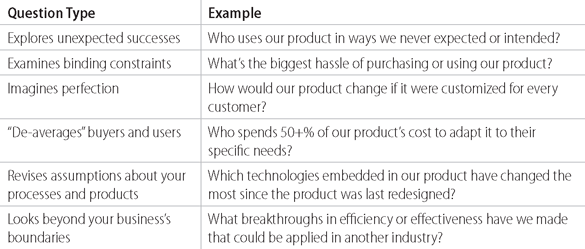Breakthrough Thinking from Inside the Box
The Idea in Brief
Imagine attending a meeting at which you and your colleagues have to invent an idea for a new business. The only instruction you're given is to "think outside the box." The task is so vague that you'd promptly give up.
Coyne, Clifford, and Dye propose a better approach: structured brainstorming. Through this process, you pose concrete questions that focus people's thinking in ways that spark fresh ideas. For example: "What businesses could we invent if we reproduced something children love in an extreme form for adults?" This notion has catalyzed creation of 25+ new product categories, including gourmet jelly beans, Spider-Man movies, and paintball. You also orchestrate the brainstorming process to help people work effectively together; for example, sequestering all the pushy people in one group so they can't dominate the others.
Structure your brainstorming, and you get a shower of great ideas you can transform into profitable reality.
The Idea in Practice
Coyne, Clifford, and Dye offer these suggestions for using structured brainstorming:
Ask the Right Questions
The best questions guide people to valuable--and overlooked--corners of the universe of possible new ideas. The authors recommend asking six types of focusing questions:
To develop your own list of questions, notice whenever you come across a new business idea that you consider really clever. Ask, "What question would have caused me to see this opportunity first?"
Orchestrate the Process
Design brainstorming sessions to be consistent with how human beings actually think and work together. For instance:
Clarify what constitutes a good idea in your particular case. Discuss constraints such as how much money your company can spend to implement an idea, what level of staffing the company can commit, and when you need a payback.
Select participants who can produce original insights. Include people who will have answers to your questions through firsthand knowledge. You may need to bring in people from outside your immediate staff, such as customers and salespeople who have direct experience with what's going on in the market.
Make social norms work for you. In meetings of 10+ people, the social norm is that most people speak only a minimum amount while a few dominate. Break large groups into groups of four, where the norm is for everyone to participate. Put pushy people into one group so they won't silence those in the other groups.
Don't rely solely on one brainstorming session. Sometimes ideas keep improving over time. To capture all the good ones, consider scheduling a follow-up meeting or two, or gather additional thoughts from individuals after the session.
Copyright 2007 Harvard Business School Publishing Corporation. All rights reserved.
- Purchase the full-length Harvard Business Review article here.
- Visit Harvard Business Online.
- See more on Leadership and Managing People at Harvard Business Online.
Further Reading
Articles
Harvard Business Review
August 2002
by Teresa M. Amabile, Constance N. Hadley, and Steven J. Kramer
In addition to structuring actual brainstorming sessions correctly, support an organizational culture that stimulates creative work during low- and high-pressure times. Start by refusing to buy into the illusion that pressure spurs creativity: It usually doesn't. On low-pressure days, encourage people to play with ideas and develop something new. Protect time-pressured creative thinkers from distractions and unrelated demands. If tight deadlines are unavoidable, explain why they're necessary. Employees feel a sense of mission (which fuels creativity) when they understand the urgent need for their work. And minimize abrupt scheduling changes. You'll reduce uncertainty, helping people to concentrate on their real work.
Tough-Minded Ways to Get Innovative
Harvard Business Review
August 2002
by Andrall E. Pearson
Pearson describes five practices that can help you further "institutionalize" innovative thinking in your organization: 1) Create a creativity mind-set; for example, by not casting blame when experiments fail. 2) Let people cross lines and take risks; for instance, by forming task forces that spur cross-functional interaction. 3) Be hardheaded about strategy by establishing boundaries around what you're trying to do for customers. 4) Look outside your firm--to competitors and customers--for potentially profitable ideas. For example, discover what's already attracting consumers, then out-execute your rivals. 5) Throw needed money, people, and programs behind your new product or service. You'll never have the first-blood advantage again.
Turn Customer Input into Innovation
Harvard Business Review
January 2002
by Anthony W. Ulwick
Customers' opinions rarely provide assistance in generating breakthrough ideas. But, says Ulwick, that's because companies ask customers, "What do you want?" That's the wrong question. When you ask customers what they want, they respond with solutions (products, services features) they've already experienced. They can't imagine new technologies or materials. To get valuable input from customers, find out what outcomes they desire. For example, medical-device maker Cordis translated cardiologists' suggestion for a solution ("a smooth balloon") into the desired outcome "Minimize risk of dissecting a vessel." Cordis used this insight to create the highly successful artery stent, which doubled the company's revenues in two years and vaulted its stock price fivefold.
